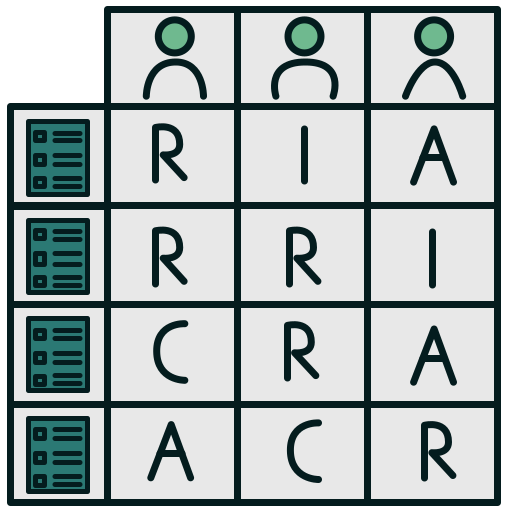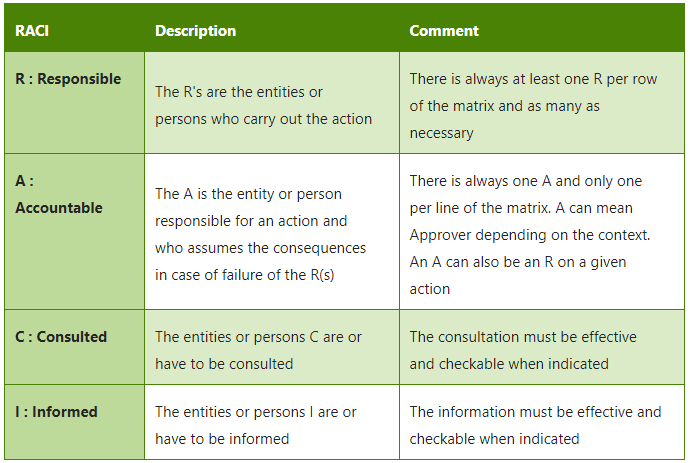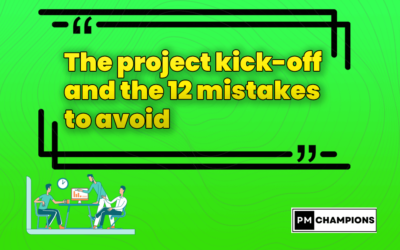Why a RACI matrix?
As discussed in the article Project Governance , the purpose of the RACI matrix is to specify the roles and responsibilities of a project’s stakeholders , the “Who does what” and the “Who is responsible for what”.

The usefulness is twofold: on the one hand, it is a question of laying the foundation for the clearest and most consensual collaboration possible between the stakeholders from the start of the project and, on the other hand, of protecting oneself from liability issues during the project if it does not go as planned.
The RACI matrix is a MUST HAVE, which only has value on a project if it is formally validated by the client!
The WHO
Since the stakeholders of a project can be individuals, groups or organizations (see the Stakeholder Management page), the roles and responsibilities appearing in the matrix are defined according to the necessary level of view.
By way of illustration, a macro RACI matrix can show the roles and responsibilities of the companies involved in the same project.
This level of information will be sufficient to feed into a framework service contract which, because it is all-encompassing, will not go into operational detail.
On the other hand, in the context of Delivery, we have to clarify things. Because the RACI matrix is an essential scoping deliverable for any project, it is necessary to produce a document that specifies the roles and responsibilities of the individuals involved in the project according to their profiles.
The project pilot is expected to provide this level of detail.
 The RACI matrix covers:
The RACI matrix covers:
- all the actors involved in the project
- The Service Provider
- The Client and its various entities
- Third Parties
- Partners
- Suppliers
- Anyone who contributes to the project
The what
Depending on the context, i.e. the purpose of the proposed matrix and the nature of the stakeholders, the granularity of information will be more or less fine-grained to detail the scope of responsibility of the stakeholders:
- By Areas of Focus for Organizations
- By activities when it comes to groups of individuals
- By tasks when it comes to individuals
Company X may be responsible for carrying out the functional design of project Y while Company X’s Business Analyst profile will be responsible for producing the detailed functional specifications of Lot 1 as part of the functional design of the same project.
The granularity of information is a key factor in the definition of a RACI matrix, and it should be:
- Matrix coherent, through calibration
- Structured for ease of readability, through categorization
- Unequivocal and unambiguous
The HOW
The RACI matrix is a table showing the different stakeholders of the project on the x-axis and the areas of intervention, activities and tasks on the y-axis.
This information is structured and prioritized. At the crossroads, one or more letters are indicated: R, A, C and/or I.
Each letter of the acronym RACI corresponds to a specific level of responsibility:
R-Responsible
Stakeholders tagged R, for Responsible, are the ones who carry out the action. Multiple stakeholders can be tagged R on the same line for a given focus area, activity, or task.
A-ccountable
The stakeholder tagged A, for Accountable (or Approver), is the one who validates and assumes the consequences in the event of a failure of the R(s). There is only one per line and it can accumulate a double responsibility R and A.
C-onsulted
Stakeholders tagged C, for Consulted, must be consulted on the mentioned focus area, activity or task. The consultation of the stakeholder must be effective, and its contribution verifiable: this is an active role.
I-nformed
Stakeholders tagged I, for Informed, need to be informed about the mentioned focus area, activity, or task. The information provided to the stakeholder must be effective and verifiable. This stakeholder plays a passive role.
A captioned matrix
It should be noted that depending on the context of the project, and in particular whether it is French or English, the letters may have nuances in terms of definition.
Care must therefore be taken to remove any ambiguities by systematically recalling what each letter means in the context of the project in question, with an explicit caption.
It is also required to specify the role, mission and any particularities associated with the letter R, A, C or I: the term corresponding to the letter is not enough.
Matrix variants
1/ RASCI
The letter S stands for Supported in the RASCI variant. The stakeholder tagged S generally provides human and/or material resources to those tagged R.
She has the same objectives in terms of carrying out actions, but not the same responsibility as a stakeholder since her active role in the project is to help others.
As a corollary to the matrix, it is strongly recommended to ensure that the stakeholder is engaged in providing the appropriate support: there is a notion of obligation behind this letter.
2/ RACI-VS
The letters V and S, for Verifier and Signatory (or Sign-Off), can be used in the RACI-VS variant. This variant is mainly implemented on projects for which the QMS is decisive (Quality Management System)
The stakeholder tagged V is in charge of verifying the quality of the work carried out by those tagged R, i.e. the adequacy with the client’s acceptance criteria.
The stakeholder, tagged S, oversees all responsibilities and approves the findings of the stakeholder, tagged V.
Be careful to distinguish between A and S in terms of decision-making.
3/ RACI+F
The letter F, for Facilitator, is sometimes used in the RACI+F variant. This approach is strictly reserved for projects delivered according to the Agile methodology .
The F-tagged stakeholder plays a facilitating and supporting role within an Agile project system.
The letter F generally addresses the topics of Scrum Mastering or Coaching.
Be careful, however, with the use of this RACI+F variant: it may seem relevant but it is not unanimously accepted by agilists.






0 Comments